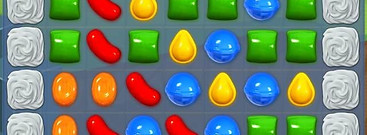Mahjongg Dimensions Blast (2010)
Mahjongg Dimensions Blast was a casual Facebook game where people make as many matches as possible within one minute. People could earn or buy boosts that would fly down and assist them in the game, or extend it.
My Role
Lessons Learned
I worked on level design as well as a game artist for boost content and a front-end developer for some bonus features.
Chaining is More Powerful than just Scoring
The game was based off an earlier iteration called Mahjongg Dimensions. Blast was a shorter game meant to be replayed over and over. A new scoring system was introduced in Blast that made it much more addictive: Chaining.
Many casual games use the concept of chaining: when a series of correct matches or correct actions in the game counts up. Any missteps and the chain is broken and resets.
Chaining should reflect scoring, but scoring itself can be abstract and hard to understand when a player's focus is on playing. Chaining has the power to add pressure to play by creating Loss Aversion. A player is motivated to continue to play well and not make a mistake or they will lose their chain and need to start over. The higher they are on the chain, the more powerful the pressure to keep that chain is. Loss Aversion is a bias that makes the loss of something twice as painful as the pleasure of gaining the same thing. This phenomenon shows up in many different areas of our lives. One common example is pricing. Sellers tend to sell items at a higher price than what buyers would pay in part because sellers think in the context of loss, and so they want to offset that loss with a higher price.
Reinforced by visuals and sound FX
We also reinforced the chaining concept with a simple musical scale that enforced this idea to players. The sound FX was much more effective in communicating a player's place in the chain than any UI heads up display (HUD). We have a visceral understanding of musical chords, compared to a number which is far more abstract. When the chain is capped at a maximum, we keep the musical pitch the same indicating that the highest state has been hit.
Art Needs to Support UX
I wrote a best-practices doc on level creation for the game. One of my main takeaway was the importance to choose icons that reflect the goal of the level. Icons were used from the previous game so there was a lot of variety. Some of the icons looked similar, some were more visually busy than others. I was able to use these differences to add to the difficulty of the puzzle, beyond layout. Icons that were different from one another or simpler in design, were easier to process and play. Icons that were similar would trip players. The takeaway is that even something as minimal as icon art can have a large impact on game feel. I might not notice it when playing, but icons that are more complex take longer to process. This microsecond delay adds to decrease my flow and makes the game feel less fun. This can explain why some match 3 games (like Candy Crush) are more successful than others with similar mechanics.

Loss aversion: The loss of something is twice as painful as the gain of the same thing.


Top: Screenshot from
GameHouse: Jewel Match Naturescapes
Bottom: Screenshot from Candy Crush